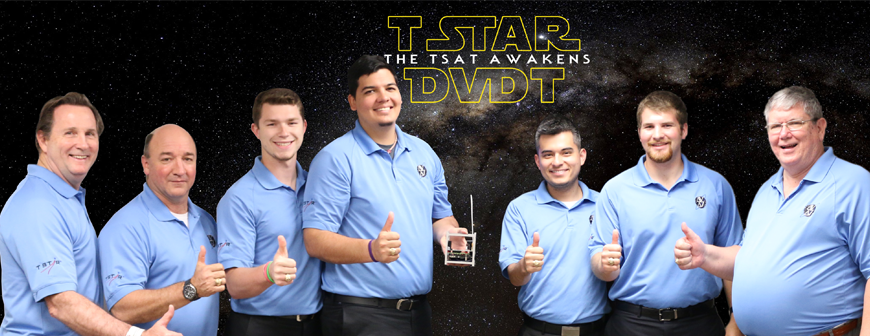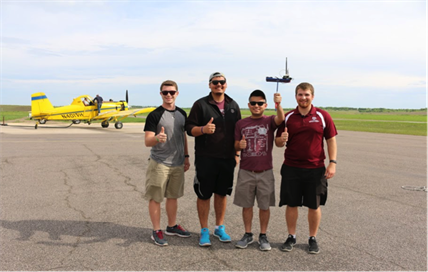
Four seniors in the Department of Engineering Technology & Industrial Distribution at Texas A&M University assembled individual strengths under a team identity — DVDT — to undertake a capstone project that was effectively launched into outer space on April 9 from Hillsboro Airport in Hillsboro, Texas. In affiliation with a T STAR initiative, the objective was to provide a communications platform for cube satellite technology (TSAT) in low-earth orbit at 400km. The students, mentored by department and industrial advisors, went on to surpass equipment requirements.
“We made a system that actually works,” said Trent Tate, team program manager. “We did field testing and found that our system could easily transmit over four times the distance to the International Space Station (1600km).”
The Electronic Systems Engineering Technology program degree plan requires that prior to graduation, seniors must solve a problem for industry and their solution must work. DVDT began developments of a Modular Integrated Stackable Layers (MISL) stack-compatible communications module in the summer of 2015. The team decided to use a high-altitude balloon filled with helium as the launch vehicle for the module, which lifted the device to 107,000 feet.
“We went into it knowing nothing about communicating in space,” said David Smith, who performed testing and simulations for the team. “Going through that process, weighing through the pros and cons...and building the system, is a good experience that we have."
Asked about trials the team faced in working on such a technical, real-world problem, Dakotah Karrer, the team’s hardware engineer, said, “When you have to integrate with multiple and different parts, it can be challenging. I communicated with NASA to know their standards. The integration aspect is important. You’re never just going to be working by yourself.”
“One of the most professional presentations I've ever seen: from its completeness, to the data they achieved and what their design looked like,” said Matt Leonard, T STAR president and industry client for the project. “T STAR is a startup company and TSat is the turnkey satellite we are developing. The communications layer is critical to the satellite being able to be on orbit and communicate its data back to earth. This was our first flight unit. Now we can say we already have a unit that has flight experience.”

Karrer is finding that sharing the video of their launch with other non-engineers is a great way to explain the type of work he and his teammates performed.
Vince Rodriguez, the team’s software engineer, added, “The videos show people what we are doing. My family really caught on to them.” He advises other students who will begin their capstone projects to ask questions, many of them.
“We as a program are investing in a number of different focus areas and one of those is spaced-based products and systems,” said Dr. Joseph Morgan, professor and one of the DVDT advisors. “The ability to partner with NASA to create this rack and stack hardware architecture for rapid prototyping and with a small business like T STAR to merge the technologies and create products, is a win-win-win.
“What was missing when we looked at our partnership with NASA and the development of this product line was the ability to communicate 400 kilometers and to do that reliably. T STAR recognized the need for this capability and this team took on that challenge, which is well above undergraduate-level work. Furthermore, their success is now allowing us to create a reference point that will inspire more teams to step up to that level. It will be difficult for future teams to ever accomplish the level of engineering design and development that this team has.”
The ultimate result of DVDT’s work is that the created device communicates reliably at a higher data rate than current cube satellite communications modules.
“Further, they proved this radio technology at distances well over 10 times the greatest distances tested by the component manufacturers,” said Mike Willey, lecturer and project faculty advisor for the team.
The team will compete in several upcoming competitions locally and nationally. In March, DVDT made a presentation at the American Society for Engineering Education Gulf-Southwest 2016 Conference at Texas Christian University.
Smith will graduate in May and will be commissioned into the United States Air Force. Tate and Rodriguez will also graduate in May and begin work at Texas Instruments, with Karrer also joining the company as a summer intern before graduating in December.